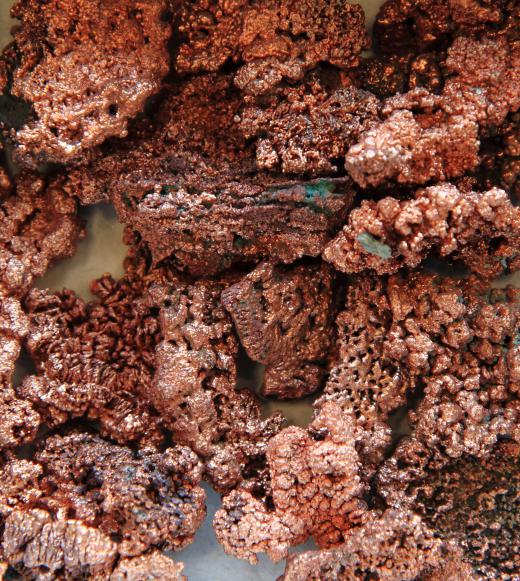What Is Metallurgical Engineering?
Metallurgical engineering is the field of engineering dedicated to working with metals. It encompasses areas including the extraction of metals from the earth, refining metal ores, and the design and production of materials made from mixtures of metals, called metal alloys. It is enormously important to fields such as manufacturing and construction, as well as to a vast array of consumer goods with metal components.
This field of engineering is commonly divided into two areas, extractive metallurgy and physical metallurgy. In extractive metallurgy, metallurgical engineering is used to extract and refine metals mined from the earth. Metals are almost always found mixed with other materials in mineral deposits called ores rather than alone and are frequently in chemical compounds rather than in pure elemental form. Before these metals can be used, they must first be removed from the ore.

This can be done with a number of different methods, depending on the ore in question. Ores can be heated to cause physical changes and chemical reactions in the ore. Chemical agents can be applied to cause chemical reactions in the compounds containing the metal. Ores can be dissolved in water heated until they are molten so that the metal can be isolated through electrical processes. Once the metal is no longer chemically joined with other elements, it is then refined to physically purify it. All of these methods depend on knowledge of metallurgical engineering.

Once metals have been obtained from the environment through extractive metallurgy, physical metallurgy is what puts them to use. One of the primary applications of metallurgical engineering is the creation of metal alloys by combining a metal with other metals or nonmetal materials. Alloys can have properties differing from their constituent parts, and a huge variety of alloys have been created to provide materials for different tasks. Most commonly, the constituent substances of an alloy are mixed by heating them enough that they melt and then mixing them together and allowing the mixture to cool and solidify. Other means of alloying materials are also possible, such as mixing them in solid powdered form and then subjecting them to great heat and pressure to combine them.
The alloy can then be subjected to a number of different treatment processes that alter its mechanical properties without changing its chemical composition. These processes can be mechanical, altering the crystalline structure of the alloy by applying forces to it to cause mechanical stress. They can also involve heating the alloy, as processes such as holding an alloy at a high temperature for extended periods of time or heating it and then rapidly cooling it off again by immersing it in cold water or oil can also affect the crystalline structure in which the atoms of the alloy are arranged. Metallurgical engineering applies scientific knowledge of the characteristics of different mixtures of substances and the physical effects of different treatments to devise a production process to create an alloy that is best suited to a given application.
Thus, metallurgical engineering is at the center of metals production industries such as steel making. It is very important to related areas such as building construction, the design of vehicles such as automobiles and airplanes, and civil engineering projects such as bridges. Additionally, metallurgical engineering is essential to the industrial manufacture of many capital and consumer goods.
The oldest known examples of metalworking date back to about 7,000 BC, when humans began using primitive weapons and tools made of copper. By 6,000 BC, humans were using fire to smelt ores containing copper to make purer metals. The first known man-made alloys date back to 3,800 BC, when metalworkers in the Middle East began alloying tin and copper to create bronze, a much more effective material for weapons and tools that would radically shape the development of civilization. People in different parts of the world discovered basic metallurgical processes independently. These events predate the idea of engineering as a specialized professional or scientific discipline by many thousands of years, of course, but the essential core of metallurgical engineering — using knowledge of metals to extract, shape, and transform them for human use — is present.
AS FEATURED ON:
AS FEATURED ON:












Discuss this Article
Post your comments